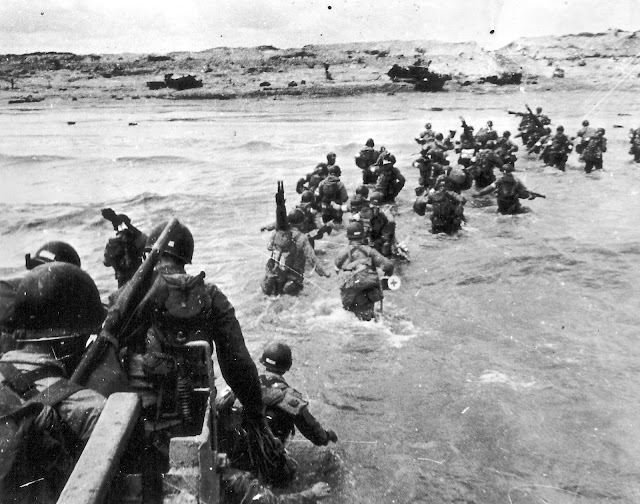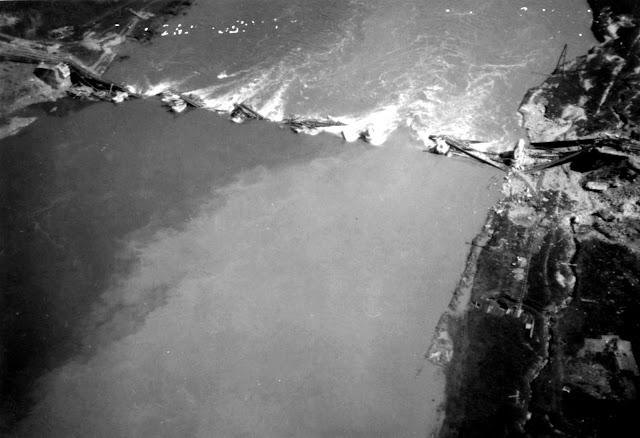SGT. ROBERT F. MORRISON, WWII: Took fight to the enemy, fell in Alsace
Sgt. Robert Frederick Morrison was one of eight children born to iron foundryman Louis Frederick Morrison, six of them, Robert included, to Louis' second wife, English immigrant Alice Mary (Roper) Morrison.
The oldest two sons, half-brothers to Alice's half-dozen children, were born to Louis' first wife, Loretta (Flynn) Morrison. Chester was 8 and little brother Louis George II was four when Loretta passed away. She'd fallen through an unfinished attic floor according to a family member and injured her back, dying later in 1913 of complications, it appears.
Widower Louis, born in Poughkeepsie in 1877 to Irish immigrant parents William and Bridget (Fallon) Morrison, 38 and 24, respectively, found a new partner eight years later in Alice Roper of Tarrytown. Alice was born in the town of Wareham, in the county of Dorset in southwest England and emigrated to the U.S. in 1915 at age 23. They married in September 1921 and were immediately a family of four with Chester, 16, and Louis, 12, gaining a stepmother. Alice gave birth to Robert in 1922, John Alfred in 1924, Clifford Thomas in 1926, Genevieve Anne -- the couple's only daughter -- in 1927, Douglas in 1928 and Donald Richard (Dick), 1930.
Alice would raise the young family alone after Louis, 14 years her senior, fell off a Village of Irvington trash collecting truck while on the job near Cedar Ridge in 1931. He broke his back and died within hours at Dobbs Ferry Hospital. Horribly, he appears to have remained conscious for at least a couple of hours before dying before Alice was able to reach his bedside. Alice was 39 at the time.
Alice was familiar with family tragedy. Eight years earlier, her sister Mary of Ardsley Park had died, leaving her husband Dennis Murray to raise an infant child by himself. Mary was about 38 when she died.
 |
| Pvt. Robert F. Morrison is shown in U.S. Army uniform c. 1944. (Photo courtesy John J. Morrison, Irvington native, nephew of Robert Morrison) |
The Morrisons would have faced some financial struggles even before Louis' death. Louis had managed to buy a single family house at 79 S. Buckhout St. in the new Spiro Park neighborhood in 1929 with help from his sister Ann, who lived with the family. He had been a skilled coremaker in the Lord & Burnham Co.'s Burnham Boiler Corporation iron foundry until it closed in 1930. It was then that he found work with the village.
After Louis' death and without his income, Alice retreated to be with her family in England with her six children in 1933. She and the family returned to Irvington in 1938 and moved into the 50 and later 48 Main Street apartments. The family would continue to have relatives living at 48 Main until 1988.
Alice was one of 12 children born to lumber yard foreman Robert Roper and his wife, Teresa (Penny) in Wareham between 1883 and 1902 She was working as a maid in Dorset before emigrating to North America through Montreal with older sister Mary, also a domestic servant in March 1915. Canada at the time was still a Dominion of the British Empire which allowed easy access to British citizens.
Young Robert, as the eldest of Alice's birth children, quit school after completing sixth grade (c. 1933) at Immaculate Conception School, the parochial school attached to the Morrisons' Immaculate Conception Church parish. He took a job at the Safeway Co. grocery store at 55 Main Street, just across the street from his family's apartment. The address appears to have been the right half of today's Irvington Dry Cleaners, having been annexed and absorbed into one facade that is now listed as 53 Main Street. The left side of that building in the 1920s, '30s and early '40s was what appears to be a butcher store specializing in high quality meats and poultry -- Irving Market.
The Safeway store transitioned into a Peter Reeves Market after it closed, Safeway being owned at the time by Reeves Market chain founder Daniel Reeves. Geordanes Neighborhood Market stands at 57 Main next door, today, but for most of the second half of the 20th century, that site was Becker's, a stationery and sundries retailer.
The Morrisons lived in an apartment at 50 Main Street above what's been a wine and liquor retailer for years (Savvy Sips Wine & Spirits today) before moving next door to an apartment at 48 Main -- a delicatessen for years, now FarmEats restaurant -- which was Robert's address when he was inducted into the Army on Feb. 9, 1944, less than a year after younger brother Clifford, 17, had enlisted in the Navy.
Robert received his induction notice on the same day as another ill-fated soldier, Alick M. Ian of Barney Park, next to the southernmost part of South Eckar Street. Both would give their lives for their country about six months apart in western Germany against the desperate defenders of a doomed Third Reich.
But first there was training for Private Robert Morrison, who joined Company A of the 141st Infantry Regiment of the 36th Infantry Division which was assigned to the Seventh Army of Gen. Alexander M. Patch.
The 141st has been long known as the 1st Texas Infantry because it was created during the Texas Revolution of Oct. 2, 1835-April 21, 1836, an uprising by independence-minded Texans against their Mexico overlords. And Company A was also historic. It was the first company formed in the 1st Texas Infantry in early 1836.
Pvt. Morrison is believed to have been sent from the U.S. to Naples, Italy in late July or early August 1944 where the Seventh Army was preparing for Operation Dragoon on the beaches of the French Riviera.
The amphibious operation was originally planned to take place at the same time as the D-Day amphibious landings of June 6, 1944 in Normandy, but was scrubbed for lack of supplies. It was resurrected in July when it became obvious that new ports would be needed to cure supply issues hindering Allied advances through Western Europe. Dragoon would open the ports of Marseilles and Toulons to the Allied supply lines and that's just what it did.
The Seventh Army landed on the beaches of the Côte d'Azur on Aug. 15, 1944 without much opposition. The Allied forces lost 95 men killed and 380 wounded on the first day of the invasion, smashing through German defenses which had been badly undermined by the transfer of the Nazi's top troops to meet the Allied onslaught in Normandy. Weakened in men and materiel, the troops that remained included the Ostlegionen made up of soldiers, some volunteers, some conscripts from the Soviet Union opposed to communism. They were given outdated and in many cases antique weapons.
German losses, mainly through men taken prisoner, were 2,000 that first day. The rest took part in a fighting retreat, but the Allies cut them off at the town of Montelimar. A weeklong battle ensued, mainly and artillery duel. When it ended on August 28th, the Germans had suffered 2,100 casualties with another 8,000 men taken prisoner. Allies losses were 1,575 wounded and killed.
By mid-September, the liberation of southern France was moving quickly, as were the Allied forces which battled German defenders in the Vosges mountains of eastern France on the border of Alsace-Lorraine not far from the German frontier. The Germans were better entrenched for defense there and were not inclined to surrender en masse.
The 1st Battalion of the 141st, which included Pvt. Morrison, was surrounded and cut off for six days in the Vosges from Oct. 24-30. Morrison was limited in what he could report home, but let it be known that his outfit had been "lost." His report was accurate and led to his 1st Battalion earning the nickname the "Lost Battalion" of World War II. Attempts by the 141st's 2nd and 3rd battalions to extricate their 1st brothers-in-arms failed. Finally, its rescue came via a segregated Nisei (2nd generation Japanese-American) all-volunteer outfit, the 442nd Regimental Combat Team, many of whose members had family members segregated in internment camps in the U.S. while they fought in Europe.
German-occupied Alsace-Lorraine.
 |
| This map of northern Alsace, shows the embattled city of Haguenau (alternatively spelled Hagenau in German) and its southeastern environs where the 141st Infantry Regiment of the 36th Infantry Division battled in the late winter and early spring of 1944-45 and where Sgt. Robert F. Morrison was killed in action on March 17, 1945. Note the Moder River (center, top) and Rhine River, the German border (bottom right). The green areas are forests. (Map courtesy Texas Military Forces Museum, 36th Infantry Division archives) |
The final words Irvington heard from Morrison were these, in a thank-you letter for gifts he received in France from Irvington residents for Christmas 1945. The letter was dated Feb. 28, 1945, 17 days before his death, and was published in the March 22, 1945 Irvington Gazette newspaper, before his death had been made known:
“I received your most welcome package for Christmas and take this opportunity to thank everyone for same. Everything will be very useful and it sure is good to know that our friends in Irvington think about us.
“We have had a pretty tough winter and I sure hope this war will be over soon.
“Sincerely yours, Robert F. Morrison”
 |
| Sgt. Robert F. Morrison is interred at Sleepy Hollow Cemetery. (Photo courtesy John J. Morrison, Morrison family) |
Morrison was promoted to sergeant posthumously and awarded the Order of the Purple Heart. His body remained in Europe until late 1948. A memorial service was held in his honor at Baker Funeral Home in Hastings on Friday, Nov. 26, 1948 with an Irvington Post 2911 Honor Guard while he lay in repose. A requiem Mass followed on the morning of Nov. 27, 1948 at the Church of the Immaculate Conception on North Broadway in Irvington followed by his burial with full military honors at Sleepy Hollow Cemetery.
Links to similar personal stories about Irvington heroes who gave their lives for their country*
◼ Pfc. Cuthbert Powell Sinkking: Class of '42 gave 3 of its own to the ages
◼ Pfc. John Joseph (Joe) Gilchrist: Died after capture of Saint-Lo
◼ Lt. (j.g.) George Eddison Haines: Lost at sea, awarded Silver Star
◼ Pfc. Joseph Thomas Costello: Teen lost life in Battle of Mindanao
◼ MSgt. James Peter Kelley: Survived WW II and Korea; died in fall
◼ S1 Archibald Ronald: Lost on next-to-last Navy ship sunk by U-boat
◼ TSgt. Raffaele R. (Ralph) Reale: A hero's life ended on East Sunnyside Lane
◼ Sgt. Robert F. Morrison: Took fight to the enemy, fell in Alsace
◼ Lt. Col. George W. Beavers Jr.: Re-upped as private; died on war's eve
◼ F2 Claude L. Bronnes: Went down with the Atlanta at Guadalcanal
◼ MMLC William James Downey: Died aboard ship off West Coast
◼ Pvt. Alick Main Ian: Died taking Aachen, first German city to fall in WWII
◼ Pfc. George Mills Hill Jr.: Survived Okinawa, only to fall in South Korea
◼ Pvt. Peter R. Robinson: Lost to shadows of time over Pacific, answers never found
WORLD WAR I












Comments
Post a Comment